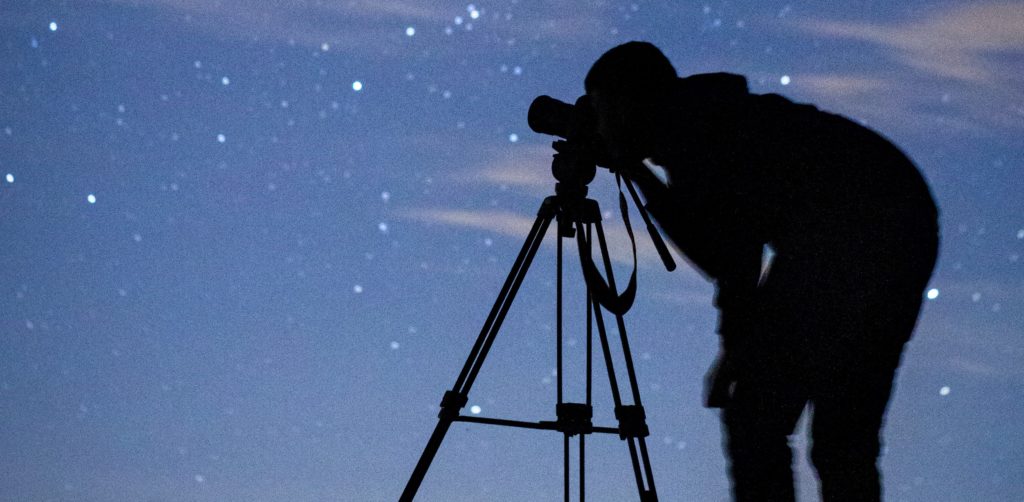
Looking for your first tripod can be overwhelming. There are so many knockoff brands on the market and filtering through the garbage to find a useful piece of equipment can take months of research and loads of dead ends. Luckily, though, Focal Point has you covered. We know that sticking to a budget is important for new photographers, but so is having the gear you need to expand your skillset. New or used, with a massive swing in price depending on what you need, our tripod inventory is fairly comprehensive. We’re also here if you have questions on tripod accessories or brands. Keep in mind that not all types of photography still require a tripod to get great photos. Portrait photographers usually go without in order to freely move around the studio and interact with the models.
If you’re interested in astrophotography, then a tripod is key to great pictures. This type of photography requires long exposures, as little movement as possible from the camera body, and a ton of patience. Your tripod has to be sturdy, able to absorb vibrations, and hold a large lens. You should expect to spend between $250-$400 for a tripod that will do all of those things. It may not be the lightest one of the bunch, but worth it for the stability. Carbon fiber tripods have recently become incredibly popular in the past several years since they’re significantly lighter than older models. However, not every carbon fiber tripod will be hefty enough to support a hobby like astrophotography. In shop, we have a whole bunch of tripods that will work; brands like Benro and Sirui are going to be prime candidates.
For landscape photographers, stability is important, but not as much of a priority as portability; having to lug a chunky piece of equipment through the forest isn’t ideal. Instead, you’ll want to research brands that specialize in lightweight gear. Three Legged Thing and Slik are companies that make tripods for hikers or those constantly on the go. Their designs are crafted to be adjustable, adaptable, and have accessories that make moving from one type of environment to another easier. Look for tripods that have 3-4 leg sections; these have a large height range that you can work with without being too wobbly or unstable. Twist locks are a favorite feature for many of the photographers that visit the shop. They don’t tend to break as easily at clamp locks.
Architecture and product photography are two other styles that usually need tripods. Used mainly in tandem with lighting equipment, these styles require crystal clear staged photos meant to highlight a unique aspect of the subject or several different angles. Wide-angle lenses are common for these styles as well. Stability and portability are essential.
Beginner’s Guide to Tripods Given all of that information, it can be tempting to buy the first tripod you see in a shop or online just to get the process over with and avoid the stress. Maybe it works out, maybe it doesn’t; but, you know what you do & don’t want in a tripod, right? Please don’t do this. Any seasoned photographer will tell you that doing so would be a mistake; it has the potential to cause you loads of trouble while also being a waste of money and time. You may also end up in a situation where you’ll desperately need all of your gear, tripod included, to function correctly. Gambling on a cheap plastic piece of junk isn’t something we’d recommend.
Some common traits of cheap tripods include being so lightweight that they simply aren’t stable regardless of the environment in which you’re using it. Whereas Benro, Manfrotto, and MeFOTO offer lightweight options that are usually made of carbon fiber and are meant for a wide range of camera setups, knockoff brands will cut corners in order to claim the “lightweight” title. Their tripod won’t usually be as tall as quality brands, the legs may have supports that make the build clunky and inconvenient, or the head won’t function in the way you want. While most tripod heads can be adjusted quickly & precisely, the budget head may move when you try to tighten it up instead of remaining steady. For photographers with telephoto lenses where the weight distribution isn’t equal over the tripod head, this is a major drawback as it makes shooting difficult. Plastic screws, cheap rubber (or none at all) on the feet, and an abysmal load capacity will make shooting on this tripod extremely frustrating.
All in all, what we at Focal Point want most is for you to walk out the door with a tripod that will last for a long time. Replacement feet are something we keep in stock. If you need a new tripod plate, we have tons. Those are easy things to replace with little consideration. If it takes several trips to the store to try out a variety of tripods, then we are all in to help! Feel free to ask questions, test out the gear with your camera, and talk to other people in the Focal Point community to get an idea of the brand and type of tripod you want. Whatever you decide on, and even if you don’t, we’re always here to lend a helping hand!
Here are a few tripod tips from the guys at the shop:
“The MeFOTO Roadtrip is a good blend of being affordable, is lightweight, and is compact. It’s a great beginner tripod that will last quite a few years.” – Andrew
“When you’re ready to step up to a professional tripod, consider a carbon fiber one. Extremely lightweight, sturdy, and durable. Benro Mach3 is a favorite.” – Nate
